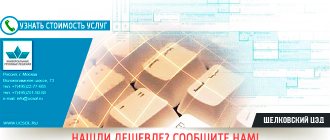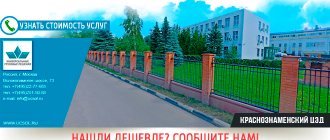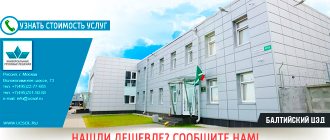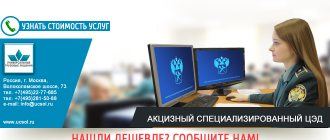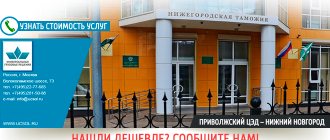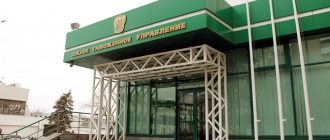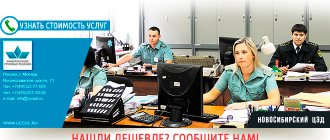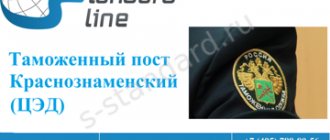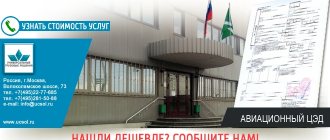HomeCustoms clearancePlaces of clearance CED Moscow CED
IMPORTANT: As of July 31, 2020, by Order of the Federal Customs Service of Russia dated April 23, 2020 N 391 “On improving the structure of the Central Electronic and Moscow Customs,” the Moscow Central Customs Office was abolished, and codes 10129060, 10129062 were cancelled. Instead, the processing of declarations is carried out by the Central CED (CCED) with code 10131010. The address of the Central CED: 107140 Moscow, Komsomolskaya Square, 1, building 4. The superior organization is the Central Electronic Customs of the Federal Customs Service of the Russian Federation, the code of which is 10131000.
Moscow CED is an electronic declaration center subordinate to the Moscow Customs of the Central Customs Administration of the Federal Customs Service of the Russian Federation. This customs authority was created by order of the Federal Customs Service of the Russian Federation dated October 6, 2010 No. 1839 and has been operating since January 12, 2011. Structurally, the CED Moscow customs post consists of two departments of customs clearance and customs control, located in different areas of the capital. OTO and TK (code 10129060) is located at: 115563, Moscow, st. Generala Belova, 16, building 4. Address of OTO and TC No. 2 (code 10129062): 109316, Moscow, Volgogradsky Prospekt, 42, bldg. 5.
Creation of TsELT
In accordance with the order of the Federal Customs Service of Russia dated February 7, 2021 No. 145 “On the creation of the Central Electronic Customs,” a main control center was formed - the first Central Electronic Customs. If we compare it with the EDC, this is a higher body that has higher competence and its decisions are more significant. In the CED, the customs inspector actually does not make independent decisions, because he acts in accordance with strict instructions. At CELT, employees perform more thorough control of declarations. They will also make a decision if, for any reason, problems arise with the release of cargo at the EDC.
VIRTUAL CUSTOMS CUSTOMS AND LOGISTICS PORTAL
In order to improve the structure of customs authorities and implement paragraph 11 of the action plan (“road map”) for reforming the system of customs authorities in the period from 2021 to 2020, approved by order of the Ministry of Finance of Russia dated January 9, 2021 No. 2, in accordance with Article 253 Federal Law of August 3, 2018 No. 289-FZ “On customs regulation in the Russian Federation and on amendments to certain legislative acts of the Russian Federation” (Collected Legislation of the Russian Federation, 2021, No. 32, Art. 5082) and by order of the Federal Customs Service of Russia dated September 26, 2011 No. 1939 “On approval of the Instructions on the procedure for maintaining the Classifier of customs authorities and their structural divisions” orders:
1. From July 31, 2021, reassign the Moscow customs post (electronic declaration center) of the Moscow Customs to the Central Electronic Customs without changing the location and staffing levels.
2. Cancel from July 31, 2021 the codes: 1) Moscow customs post (electronic declaration center) of Moscow customs -10129060; 2) department of customs clearance and customs control No. 2 of the Moscow customs post (electronic declaration center) of Moscow customs - 10129062.
3. Assign a code to the Moscow customs post (electronic declaration center) of the Central Electronic Customs from July 31, 2021 - 10131010.
4. Rename from July 31, 2021 the Moscow customs post (electronic declaration center) of the Central Electronic Customs (code 10131010) to the Central Customs Post (electronic declaration center) of the same customs (code 10131010).
5. From July 31, 2021, determine the Russian Federation as the region of activity of the Central Customs Post (electronic declaration center) of the Central Electronic Customs.
6. Add from July 31, 2021 to the annex to the order of the Federal Customs Service of Russia dated July 26, 2021 No. 1464 “On the location and regions of activity of customs authorities of the Central Customs Administration” (as amended by orders of the Federal Customs Service of Russia dated August 29, 2021 No. 1645 , dated September 9, 2021 No. 1754, dated December 2, 2016 No. 2268, dated December 9, 2021 No. 2314, dated December 29, 2021 No. 2454, dated April 14, 2021 No. 573, dated May 17, 2021 No. 821, dated July 5, 2021, No. 1119, dated September 14, 2021, No. 1491, dated December 1, 2017, No. 1906, dated April 27, 2021, No. 606, dated May 8, 2021, No. 662, dated May 29, 2021 No. 808, dated August 29, 2021 No. 1349, dated February 5, 2019 No. 191, dated June 3, 2021 No. 894, dated June 3, 2021 No. 899, dated June 10, 2021 No. 942, dated July 24, 2021, No. 1216, dated February 20, 2020, No. 192, dated March 25, 2021, No. 306) the following changes:
1) subclause 10.5 is declared invalid; 2) add clause 16 in accordance with the appendix to this order.
7. The Central Customs Administration (Rybkin S.V.) ensure: 1) compliance with the legislation of the Russian Federation when carrying out the activities specified in paragraph 1 of this order; 2) making changes to the staffing schedules of the Moscow and Central Electronic Customs, stipulated by this order.
8. The heads of structural divisions of the Federal Customs Service of Russia take the necessary measures to update legal acts establishing the competence of the customs authorities of the Russian Federation to carry out customs operations, in connection with the publication of this order.
9. Control over the implementation of this order shall be assigned to the deputy head of the Federal Customs Service of Russia A.A. Moskalets.
Head V.I. Bulavin
Appendix to the order of the Federal Customs Service of Russia dated April 23, 2021 No. 391
| 16 | Central Electronic Customs | 10131000 | 107140, Moscow, pl. Komsomolskaya, 1, building 3 | Russian Federation |
| 16.1 | Central customs post (electronic declaration center) | 10131010 | 107140, Moscow, pl. Komsomolskaya, 1, building 4 | Russian Federation |
Head of the Main Organizational and Inspectorate Directorate I.A. Kuzminov
Reality and risks
The creation of a new customs authority, subordinate to the Central Customs Administration, is carried out as part of the digitalization and automation of customs declarations. This is one of the areas of large-scale reform aimed at transforming customs and using artificial intelligence. The introduction of the latest technologies is necessary for fast and convenient information interaction with internal and external partners. It is believed that this transformation will create more comfortable conditions for business, ensure transparency of customs work, reduce time for the release of goods and uniformity of customs operations, and eliminate the need to transport uncleared goods deep into the country.
Thus, by creating TsELT, the leadership of the Federal Customs Service promises to optimize the work of customs, but in reality it is not clear how exactly this progress will be achieved. For now, especially at the stage of formation and transformation, there are high risks of delays and confusion in the export and import of goods. And there are reasons for this. The main one is the lack of a sufficient number of qualified personnel. While in Moscow the forecast is quite favorable, in the regions the situation on this issue is less optimistic. There are not enough personnel. The high responsibility of officials and relatively low wages do not contribute to filling vacant positions. TsELT is staffed with personnel from the customs authorities of the Central Federal District. The latter are declining.
After the transfer of CEDs to the jurisdiction of CELT, the processing of documents is expected to slow down. You will need to get used to innovations and changes in business processes, perhaps retraining local employees. It will take some time to stabilize the work. The problem will be especially acute in industry-specific EDCs and EDCs in large cities. In fairness, it must be said that on-site personnel training is already carried out using virtual simulators, which should ensure adaptation to the real operating mode and reduce the likelihood of problems arising.
Since information from EDCs will now be transferred to TsELT and additional capacities will be used for this, there is a possibility of technical and software failures at the initial stage, which will also negatively affect the speed of customs clearance.
Potential risks exist, and foreign trade participants need to be prepared for delays in customs clearance of goods. I'm glad this problem is temporary. If we are guided by the experience of launching the Aviation CED, then approximately six months after the launch, the CELT will operate at a constant pace.
Central Electronic Customs: opening does not mean declaring
By the end of this year, the process of forming a network of electronic customs offices should be completed in Russia.
There will be eight of them in total. To the existing North Caucasus, Volga, Ural and Siberian in 2020, the Southern, Far Eastern, Northwestern and Central Electronic Customs (CElT) will be added. The latter opened on February 20 in accordance with the order of the Federal Customs Service of Russia No. 145 of February 7. Sergei Belyaev became the acting head of TsELT. According to open data, he has been working in customs authorities since October 19, 1993. He worked his way up from a senior inspector of the customs guard detachment of the Tolyatti customs to the head of the AvtoVAZ customs post of the Samara customs. In September 2021, he was appointed deputy head of Nizhny Novgorod customs. This is where the information about CELT ends. The official website does not yet have a department structure, a personal appointment schedule, or a brief description of the functionality.
“Logirus” decided to figure out how they will launch one of the largest electronic customs offices in the country? Where do you plan to look for personnel? What will the newly formed structure be responsible for? What “growing pains” threaten CELT at its formation stage? And also what and how should participants in foreign economic activity (in foreign economic activity) prepare for?
Logirus asked these questions to a representative of the Central Customs Administration, as well as to “top” market experts, including:
Head of the Central Customs Administration of the Federal Customs Service of Russia
Sergei Rybkin
Chairman of the Legal Committee of the NP "Guild of Professional Participants in Foreign Economic Activity" HERMES ", Expert of the Association of SRO "National Association of Customs Representatives" Marianna Chugaeva
Head of the Open Customs project Alexander Myakota
technical director of Transcertico Alexey Inshakov
Head of Unitex Foreign Economic Activity Department Sergey Prantikov
Central electronic Terra Incognita
Work to ensure the activities of TsELT is carried out in accordance with the “road map” for reforming the customs system from 2021 to 2021, said the head of the central customs department, Sergei Rybkin.
However, he refrained from disclosing details on the stages of launching the new TsELT. According to Logirus, TsElT is not yet operational. Registration takes place in the same central economic centers and in the same way as it was done before February 20, foreign trade participants clarify. At this stage, the structure, which exists only on paper, is occupied with organizational issues. In particular, the formation of personnel, believes the head of the Open Customs project, Alexander Myakota. In this case, the first step is to search for candidates for key positions.
“The central electronic customs office is not yet operational. Registration takes place in the same EDCs and in exactly the same way as it was done before February 20.”
“Electronic customs, as a higher authority compared to the Electronic Declaration Center (EDC), should have higher competence in processes related to information analysis and decision-making,” believes Alexander Myakota. – In EDCs, thanks to automation, inspectors’ functions become operator functions. They operate according to strict instructions and software algorithms, and the possibility of making independent decisions is minimized. Employees of electronic customs departments perform the functions of more thorough control, which requires special competencies.
According to Sergei Rybkin, during the transition period, the structural divisions of TsELT will be formed in stages. It is planned to staff them with officials from the customs authorities of the Central Federal District who are subject to layoffs, graduates of industry universities, as well as citizens entering the service on a competitive basis. After the reassignment of the Moscow EDC to the Central Electronic Customs, the total staffing level of the customs office will exceed 600 people.
System of electronic customs and electronic declaration centers
– In order to adapt officials to work in CELT, two virtual servers with information systems of the test customs post of the electronic declaration center and the test customs post of actual control were deployed in the Management Data Processing Center. Officials of the Moscow CED, hired for the first time, undergo training on the “Electronic Declaration Center” simulator,” explained Sergei Rybkin.
According to Logirus, TsELT may begin production directly no earlier than May–June. And it is planned to reach full capacity in the fourth quarter of 2021, summed up the head of the Central Customs Administration.
Regarding the functionality of the created TsELT, the interviewed experts are still making only assumptions. For example, Alexander Myakota believes that TsELT will become a kind of “Federal Customs Service of Russia in miniature” for the Central Federal District. The main task of the newly formed structure may be post-control and analysis of the issued or issued declaration file, suggested the interlocutor of Logirus.
– Where the EDC cannot make a decision, he will have to contact a higher organization to make a decision. That is, to the Central Electronic Customs,” says the expert.
“The numbers may vary from region to region, but on average a young inspector can count on a salary of about 20,000 rubles”
For example, the importer will submit a declaration containing a certificate of form “A” or the so-called “certificate of origin,” continues Alexander Myakota. How to present this document under the conditions of electronic declaration? Alternatively, the declaration may be issued conditionally with the requirement to provide a certificate of origin in paper form.
“This is just an isolated example of what, in practice, one of the departments of the Central Electronic Customs may need,” summarized the interlocutor of Logirus.
Why did the hearts of the departments of foreign economic affairs skip a beat?
Since, in fact, TsELT is not yet functioning, Logirus, together with market participants and experts from industry associations, analyzed the typical risks that the newly formed structure, and therefore foreign trade participants, may face.
Risk No. 1: long-term formation of personnel
The main reason for their occurrence is low wages and high responsibility, notes Alexander Myakota, head of the Open Customs project. We are talking about the inspector staff. Figures may vary from region to region, but on average a young inspector can expect a salary of about 20,000 rubles. In this regard, there are no queues of those wishing to get a job at customs.
For example, when the Siberian Electronic Customs was launched in 2021, 67 staff positions were provided. Of these, only 15 people are in the Electronic Declaration Center. And only by the end of 2021, the customs staff, together with the customs post, is planned to be increased to 279 people.
Risk No. 2: delays in processing
Based on the experience of launching the Aviation EDC, at first declarations may be issued 2-3 times slower, does not exclude the technical director of Transcertico, Alexey Inshakov. This structure was put into operation at once and concentrated the entire Moscow aviation hub, which led to a sharp increase in the declaration volume.
– If before that, on average, we graduated in 1 day, and in the best case, in four hours, then after the launch of the Aviation EDC, it began to take 2, and for some colleagues three, or even four days to graduate. Over time, the situation leveled out. Now, according to our observations, in particular, declarations, the EDC is working stably. However, this took a lot of time – about six months,” recalls Logirus’s interlocutor.
“At first, declarations may be issued 2-3 times slower”
There were also delays in the launch of the Moscow Regional EDC, the expert adds. Although the posts of the Moscow regional customs were connected in batches in batches. The main problem was the lack of qualified personnel in the required quantity.
And when CEDs do not have time to issue a declaration on time, there is a practice of requesting minor clarifications, adds Sergei Prantikov, head of the foreign economic activity department at Unitex.
– A couple of times we were asked for clarification on the technical description of the imported goods. Moreover, completely insignificant, figuratively speaking, placement of commas was checked. But these are isolated cases that occur, for example, after long holidays, when a large volume of cargo accumulates at customs, the expert emphasized.
Risk #3: technical collapse
Since the TsELT will accumulate a colossal amount of information from all central EDCs, there is a risk of a technical collapse at the initial stage, Sergey Prantikov does not rule out.
For example, failures may occur during the exchange of information between the EDCs and the ELT. At the same time, no one can be protected from the loss of some data.
– And when there are technical failures, it is difficult to predict the time frame for when these problems will be corrected. Naturally, these are nerves,” admits the interlocutor of Logirus. – After all, planning and understanding when the cargo will be processed and delivered to the customer’s warehouse is important for every company.
“Since the TsELT will accumulate a colossal amount of information from all central EDCs, there is a risk of a technical collapse at the initial stage”
Transcertico technical director Alexey Inshakov expressed similar concerns. With a high degree of probability, some situation will arise that was not taken into account in advance, or they were preparing for one volume of the declaration array, but in fact they were faced with something completely different, the expert argues.
“With us, the first pancake is always lumpy, as they say,” stated the interlocutor of Logirus.
Risk #4: automation errors
It is important to eliminate the risk of shifting errors that may be made by electronic customs onto participants in foreign trade activities, says Marianna Chugaeva, chairman of the legal committee of the NP “Guild of Professional Participants in Foreign Economic Activity “HERMES”, expert of the Association of SRO “National Association of Customs Representatives”.
– Issuing declarations in an hour, in forty minutes is, of course, excellent. The main thing is that two years after carrying out a scrupulous check after release, it does not turn out that the foreign trade participant retroactively needs to accrue an additional couple of million customs duties. I see this as a big risk for automation processes in general,” the expert emphasized.
To eliminate such risks, it may be necessary to revise the control rules after release, Logirus’ interlocutor did not rule out.
Ready means armed
Taking into account all the above risks, the head of the Unitex foreign trade department, Sergey Prantikov, advises to include increased transit times for customs clearance - 1-2 days.
At least at the initial stage of launching TsELT. “This will provide additional insurance in case of delays in the clearance of goods and will minimize the risks of failure to fulfill obligations to customers,” Sergey Prantikov is sure.
In addition, you need to pay special attention to preparing the package of documents when filing a declaration in order to provide the most complete information, adds Alexey Inshakov, technical director of Transcertico. In order, figuratively speaking, to anticipate all possible questions that an inspector may have and reduce the risks that the risk management system will respond to.
“As our practice shows, this has a positive effect on deadlines,” summed up Alexey Inshakov.
An expert from the SRO Association “National Association of Customs Representatives” Marianna Chugaeva advises to always have a backup option at the place of filing the declaration in case the Central Electronic Customs cannot cope. As an example, the interlocutor of Logirus gave the example of issuing passports for self-propelled vehicles.
– At the Siberian Electronic Customs they are issued literally the next day if the company is classified as low risk. Because the workload here is not as busy as in the Central Federal District or the Northwestern Federal District. And in St. Petersburg, for example, it can take weeks to resolve similar issues.
Main reform trends
Along with the formation of a new customs authority, from June 29, 2020 to March 1, 2021, in accordance with the order of the Federal Customs Service No. 228-r, an experiment is being conducted to divide competence in the field of customs operations.
Since July 31, 2021, the department has been operating the Central Customs Post Electronic Declaration Center (101 310 10), telephone number - (495) 276 36 62. It is planned to include under the jurisdiction of TsELT and some branch capital CEDs. The regions will also have their own electronic customs offices. They are expected to appear by the end of 2021. In addition to the existing Ural, Siberian, North Caucasian, and Volga regions, Southern, Northwestern, and Far Eastern customs will operate.
In general, the main reform trends are the unification of some temporary storage warehouses and central economic centers, division of powers and narrowing of competence, subordination of regional customs posts to the Main Center. This means that in the regions it will no longer be possible to independently clear customs or clear cargo. It will be necessary to send information to CELT via open communication channels. In this case, all interaction between regional customs brokers, customs posts, logistics areas and Moscow takes place via email.
If the CEDs are subordinate to the CELT, then the customs posts of actual control can no longer release cargo without the participation of the CEDs. In other words, it will soon be impossible to register regional cargo and prepare the necessary documentation on the spot. Registration will now take place using the Electronic Customs Center. Regional tampars contact the employees of this center via mail and submit appropriate requests. And the employees located at the Electronic Customs Center prepare the necessary documentation in electronic and paper form and do all the preparatory formal work. In order for imported cargo to be unloaded on the customs territory of the Russian Federation, approval must come from the Main Center. When all this is completed, you can further carry out customs clearance.
At the moment, a complete restructuring of the entire system is taking place, the destruction of old connections and the creation of new ones. All this disrupts the usual well-functioning schemes, which of course negatively affects the speed of customs clearance. If previously the number of participants in the customs clearance process was minimized, and they could all interact freely with each other, resolving certain controversial issues on their own, now this is not within their competence: all processes pass through Moscow, and interaction becomes as transparent as possible.
Moscow CED
Moscow CED - contact information
Moscow CED is an electronic declaration center subordinate to the Moscow Customs of the Central Customs Administration of the Federal Customs Service of the Russian Federation. This customs authority was created by order of the Federal Customs Service of the Russian Federation dated October 6, 2010 No. 1839 and has been operating since January 12, 2011. Structurally, the CED Moscow customs post consists of two departments of customs clearance and customs control, located in different areas of the capital. OTO and TK (code 10129060) is located at: 115563, Moscow, st. Generala Belova, 16, building 4. Address of OTO and TC No. 2 (code 10129062): 109316, Moscow, Volgogradsky Prospekt, 42, bldg. 5.
- Customs authority and HTO code: 10129060
- HSE Code No. 2: 10129062
- Address: 107140, Moscow, Komsomolskaya square, 1
- OTOiTK address: 107140, Moscow, Komsomolskaya sq., 1
- Address OTOiTK No. 2: 107140, Moscow, Komsomolskaya sq., 1
- And about. head of the customs post
- Deputy head of the customs post
- OTOiTK phone number
- OTOiTK phone No. 2
Customs posts located in the area of activity of the Moscow CED
- Yeletsk customs post (code 10109010) Lipetsk customs
- customs post Novolipetsk Metallurgical Plant (code 10109020)1 Lipetsk customs
- Right Bank customs post (code 10109030) of Lipetsk customs
- customs post Stinol (code 10109040) Lipetsk customs
- Novo-Yaroslavsky customs post (code 10117010) of Yaroslavl customs
- Rybinsk customs post (code 10117030) of Yaroslavl customs
- Yaroslavl customs post (code 10117050) Yaroslavl customs
- Kostroma customs post (code 10117080) Yaroslavl customs
- Sharya customs post (code 10117090) of Yaroslavl customs
- Novomoskovsk customs post (code 10116020) of Tula customs
- Tula customs post (code 10116030) of Tula customs
- Moscow customs post (code 10116050) of Tula customs
- Ryazan customs post (code 10116060) of Tula customs
- Zheleznogorsk customs post (code 10108020) of Kursk customs
- Kursk customs post (code 10108030) of Kursk customs
- OTOiTK No. 2 of Kursk customs post (code 10108032) of Kursk customs
- Mirny customs post (code 10108060) of Kursk customs
- Krupetsky customs post (code 10108070) of Kursk customs
- department of customs clearance and customs control No. 2 of the Krupetsky customs post (code 10108073) of Kursk customs
- Oryol customs post (code 10108080) of Kursk customs
- OTOiTK No. 2 Oryol customs post (code 10108082) Kursk customs
- Moscow railway customs post (code 10129020) of Moscow customs
- Left Bank customs post (code 10104030) of Voronezh customs (from 04/01/2020)
- Rossoshansky customs post (code 10104050) of Voronezh customs (from 04/01/2020)
- customs post Voronezh Airport (code 10104060)2 Voronezh customs (from 04/01/2020)
- Right Bank customs post (code 10104070) of Voronezh customs (from 04/01/2020)
- Voronezh north-eastern customs post (code 10104080) of Voronezh customs (from 04/01/2020)
- Tambov customs post (code 10104100) of Voronezh customs (from 04/01/2020)
Help SB Cargo
Our company positively assesses the changes taking place. SB Cargo provides customs clearance services in Moscow and the Moscow region, is a participant in the “Charter of Bona fide Participants in Foreign Economic Activity” and complies with the law. We are ready to help regional companies, regional businesses and industries with customs clearance of goods. We have positive experience in this, and we are aware of all the latest innovations.
A regional customs broker, through electronic interaction with the Electronic Customs Center, can process all the necessary documentation, but customs brokers in Moscow and the Moscow region are located in close proximity to the Center, so specific situations and problems in Moscow are processed much more quickly. If there is any innovation in the work of CELT, our representatives will be able to quickly change their tactics and quickly process the cargo.
Background information about the Central EDC
| Full name | Central customs post (electronic declaration center) |
| Short title | t/p Central (TsED) |
| Customs post code | 10131010 |
| Status | valid from 07/31/2020 |
| customs Department | without specialization |
| Customs clearance | carried out |
| Address | 107140 Moscow, Komsomolskaya square, 1, building 4. |
| [email protected] | |
| Phones | +7(495)393-78-71 |
| Fax | +7(495)393-78-71 |
| Official site | Go to website >>> |
| OKATO code | 45000 |
| SOATO code | 1145 (Moscow city) |
| Operating mode | from 9:00 to 21:00 - daily |
